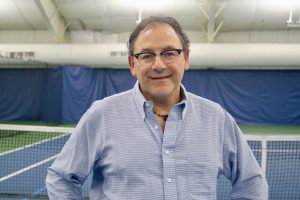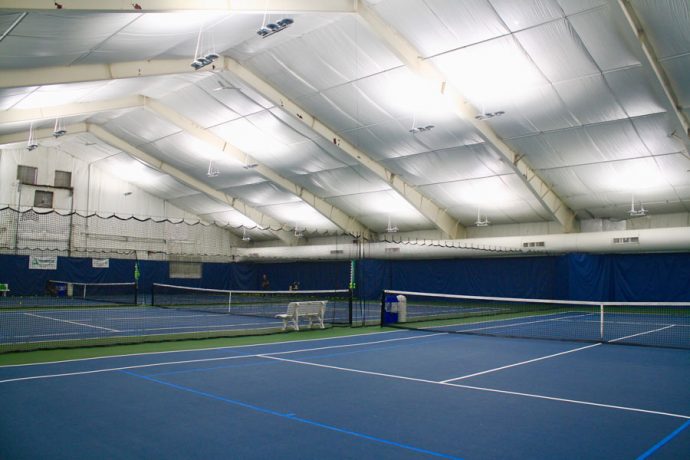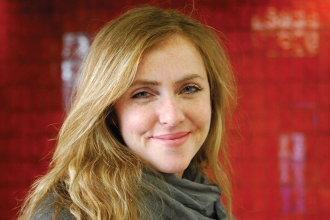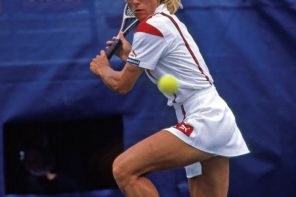The match turned competitive when our instructor, Ed, showed me where to point my feet so my serve would land where I wanted it to.
We were on the court at Yonkers Tennis Center (YTC), playing doubles, using orange-colored balls. Their slower speed and lower bounce allow players to hone their skills and still have fun. Finally, I was able to connect more with my racket, thus crushing my opponents after their early lead.
I didn’t care they were children under age 10.
The boy on the right had a monster serve and the girl on the left played with such good nature and lack of frustration it only egged me on. We won by a point. My partner still looked disappointed in me, though.
No matter. He was dependent on me for a ride home.
“When parents start to win points, they get just as excited as the kids do,” said Thane Schweyer, assistant general manager of club operations at YTC. He’d seen this outcome before. Playing tennis is infectious when it’s made simple yet competitive for mixed-level players.
I celebrated our win maybe too exuberantly but I had finally learned to serve correctly. I had also learned that Ed’s a patient man.
My competitive antics and my son’s feigned disappointment were part of a running joke during our match. We left determined to continue our shtick — as well as our reign as champions — when we played again.
This was Parent and Family Week at YTC, a Yonkers institution that itself has been in the same family for 47 years. Owner and President Joseph Curto Jr. and staff implemented the inclusive event in an attempt to involve parents and encourage them to be more active with their kids. (There’s also free open time weekdays for family members of young players.)
“It helps (their progress) if parents play with them,” Schweyer said.
During most practices, however, I can be found lounging behind the picture windows overlooking the center’s six Plexicushion hard courts, drinking a cup of complimentary tea and using the center’s Wi-Fi. For my son’s next lesson, I’ll be back at my post but, thanks to those orange balls and YTC’s encouragement, we’ll be playing together more often now on our own.


BALLS FOR ALL
The United States Tennis Association (USTA) introduced its 10 and Under Tennis program in an effort to match and evolve the game in tandem with the skill level of young players.
“(The USTA) wanted kids to have more success playing the game,” Schweyer said.
The modified format utilizes a colorized ball progression of red, orange, green and yellow. The balls have varying degrees of compression that create more opportunity for players to become tactically sound. “The idea is that kids can rally and play the game in a more efficient way,” Schweyer added. “They’re learning through doing.”
Before the change, youth tennis lessons used repetitive technical drills. Players would receive balls from the instructor without mimicking the rally. It’s a method that doesn’t translate to the adjustments players need to make during an actual game, Schweyer said. “Every shot and every situation is different. This allows us to do both.”
The sticking point for Schweyer is that while the colored-ball system is targeted for kids, it has the potential to revolutionize the game for everyone.
No matter what level player you are, “this is going to help your game,” he said. Players can practice using their body more efficiently and learn to control movement and ball spin to achieve a stronger stroke.
“I don’t think enough pros understand that,” he said. “We don’t teach school the same way we did 30 years ago.” There’s still a lot of pushback in the industry for professionals to play only with the standard yellow balls.
“Yonkers was one of the first facilities to truly embrace (this program),” Schweyer said. “It’s why I chose to come here.”
Schweyer uses the green balls for adult orientations. This gives him a talking point. “So much happens in two seconds,” he said. “If you can give someone a little bit of time, it helps.”
A slower ball also allows people to trust their swing, and Schweyer thinks it could reduce instances of tennis elbow. “Even if you’re experienced, if you’re a little bit late (with your racket), you compensate with your arm.
“(Tennis) is easy to learn, hard to master,” he added. Using orange ball allows him to play competitively with his wife. When you can increase the frequency of ball contact and expand your pool of tennis partners to play a competitive match, it’s a win.
THE COMMUNITY WINS
YTC hosts free events for U.S. veterans and will be offering tennis programs at three Yonkers Public Schools.
“Joe (Curto, owner) is very much about giving back to the community,” Schweyer said. Curto’s desire to share a passion for the game sets the bar.
“Our moniker for success is not the amount of people who play here, it’s the amount of players that play in general,” Schweyer added.
In that vein, programs at YTC are developed to encourage a lifelong involvement with the game. “It’s a sport of relationships, health and wellness,” said Schweyer who’s played tennis since he was 5. “I met my best friend on the tennis court.”
YTC also offers the paddle sport pickleball. “The beauty of pickleball is that within 10 minutes someone can learn the game.” It’s popular among seniors and gaining momentum on college campuses. “Anybody can pick it up,” Schweyer said. “You don’t have to have a great technique, just get it over the net.”
This fall, YTC will introduce a cardio-tennis fitness program. “It’s the most fun thing I’ve seen on a tennis court,” he said. “And everyone can do it because of the (red and orange) balls.”
During summer camp, older kids are encouraged to volunteer as coaches in training. Their goal is to give 100 high-fives a week to young campers who earn points for things like character, picking up balls, effort, listening well and enthusiasm.
Eventually these volunteer coaches can graduate to junior pros, which are paid positions. “They get to be around the sport they enjoy doing and might think about as a career,” Schweyer said.
They came for fun but the end result is that everyone seems to be improving at YTC.
“Everybody plays for different reasons,” Schweyer said. “Even if you came for a workout, we want you to learn a little while you’re here.”
For more, visit yonkerstennis.com.





